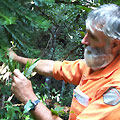
Behind
the Scenes with Chris Pavich
Chris
Pavich has worked as a NSW National Parks and Wildlife Service (NPWS)
Ranger in the Wollemi National Park area for the past 16 years.
He was therefore on hand to assist in researching the Wollemi Pine
when David Noble, a fellow ranger, first discovered the Jurassic
conifer in 1994.
"I
was really excited to learn that something extraordinary had been
found in my patch and I worked closely with David and Wyn Jones
from NPWS to find out if anyone in the region had knowledge of this
very unusual tree," Chris explains.
Chris
is one of the few select researchers permitted to visit the Wollemi
Pines in the wild in his role as the site manager and member of
the Wollemi Pine Recovery Team since 1997. His main responsibilities
include site monitoring, site security and fire management in the
area.
A
key concern for Chris is unauthorised visits to the site as diseases
and root pathogens could be introduced to the fragile wild population
via the boots of walkers. Bushwalkers could also trample the seedlings
on the forest floor which would destroy the chances of new trees
developing among the population.
To
ward of unwanted visits, the NPWS will fine any person closer than
500 metres to the wild population without the consent of the NPWS
Director General. Penalties of up to $220,000 also apply to people
found to be damaging the wild population, as specified under the
National Parks and Wildlife (Land Management) Regulation (1995).
Chris
regularly conducts site surveillance patrols to deter potential
visitors and reduce the threats posed to the site. He also acts
as a community liaison officer to ensure neighbours in the Wollemi
National Park are on the look out for illegal visitors.
Chris'
authorised visits to the site are conducted in accordance with the
Wollemi Pine Access Strategy as set out in the Wollemi Pine Recovery
Plan to minimise threats to the Pines in the wild.
"We
ensure that there is limited and careful movement of researchers
about the site so as to reduce the impact of soil compaction and
to eliminate seedling trampling. Site hygiene is also vital so all
gear and boots are disinfected and new gear used when appropriate."
Chris
believes that by educating the public about the dangers of visiting
the site, threats to the wild population will be reduced and the
Wollemi Pines will have the opportunity to survive undisturbed for
millions of years to come.
Prior
to his current role, Chris has had 30 years of experience working
on various conservation projects in Australia and overseas. He has
conducted geomorphological fieldwork in the Kimberly region in Western
Australia, worked on the establishment of the Canberra Nature Park,
and has also been based in the UK as an engineering geologist.
Stay
tuned to hear more about people like Chris who are working to conserve
and protect the Wollemi Pine for current and future generations
to enjoy.
For
more on the Wollemi Pine Recovery Plan. 
|


